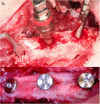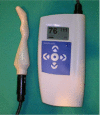Bone implant sockets made using three different procedures: a stability study in dogs
- PMID: 24558558
- PMCID: PMC3917627
- DOI: 10.4317/jced.50803
Bone implant sockets made using three different procedures: a stability study in dogs
Abstract
Objective: This study compared the effects of three different methods of preparing bone implant sockets (drilling, osteotomes, and piezoelectric device) on osseointegration using resonance frequency analysis (RFA).
Study design: An experimental prospective study was designed.
Material and methods: Ten adult beagle dogs were studied. After 5 weeks, 23 out of 28 initially placed implants in the iliac crest were evaluated, comparing these three different procedures of bone implant socket. Student's t-test (paired, two-tailed) was used to reveal differences among the three groups at each time point (SPSS 16.0, IL, USA).
Results: After a 5-week healing period, the implants placed in sockets that were made using an osteotome or piezoelectric device were slightly more stable than those made by drilling. Reduced mechanical and heat injury to the bone is beneficial for maintaining and improving stability during the critical early healing period.
Conclusion: Using RFA, there was evidence of a slight increase in implant stability in the iliac crest after 5 weeks of healing when the implant socket was made using a piezoelectric device or expansion procedure as compare with the drilling method. Key words:Bone implant sockets, drilling, osteotomes, piezoelectric, resonance frequency analysis, stability.
Figures
Similar articles
-
Bone remodelling after regenerative procedures around implants placed in fresh extraction sockets: an experimental study in Beagle dogs.Clin Oral Implants Res. 2011 Oct;22(10):1131-1137. doi: 10.1111/j.1600-0501.2010.02084.x. Epub 2011 Jan 20. Clin Oral Implants Res. 2011. Retraction in: Clin Oral Implants Res. 2018 May;29(5):539. doi: 10.1111/clr.13096. PMID: 21251082 Retracted.
-
Resonance frequency analysis (RFA) and insertional torque (IT) stability comparisons of implants placed using osteotomes versus drilling techniques: A preliminary case study.Quintessence Int. 2015 Oct;46(9):789-98. doi: 10.3290/j.qi.a34453. Quintessence Int. 2015. PMID: 26159207 Clinical Trial.
-
Implant stability measurements for implants placed at the time of extraction: a cohort, prospective clinical trial.J Periodontol. 2005 Mar;76(3):391-7. doi: 10.1902/jop.2005.76.3.391. J Periodontol. 2005. PMID: 15857073 Clinical Trial.
-
Stability and marginal bone loss in implants placed using piezoelectric osteotomy versus conventional drilling: systematic review and meta-analysis.Med Oral Patol Oral Cir Bucal. 2021 Mar 1;26(2):e226-e237. doi: 10.4317/medoral.24146. Med Oral Patol Oral Cir Bucal. 2021. PMID: 33247573 Free PMC article.
-
Piezoelectric surgery versus conventional drilling for implant site preparation: a meta-analysis.J Prosthodont Res. 2018 Oct;62(4):391-396. doi: 10.1016/j.jpor.2018.04.004. Epub 2018 May 26. J Prosthodont Res. 2018. PMID: 29843978 Review.
Cited by
-
Implant stability in different techniques of surgical sites preparation: an in vitro study.Oral Implantol (Rome). 2014 Dec 27;7(2):33-9. eCollection 2014 Apr-Jun. Oral Implantol (Rome). 2014. PMID: 25694799 Free PMC article.
-
Low-level laser therapy, piezocision, or their combination vs. conventional treatment for orthodontic tooth movement : A hierarchical 6-arm split-mouth randomized clinical trial.J Orofac Orthop. 2024 Mar;85(2):110-122. doi: 10.1007/s00056-022-00427-1. Epub 2022 Sep 21. J Orofac Orthop. 2024. PMID: 36129485 Clinical Trial. English.
-
The effects of surgical preparation techniques and implant macro-geometry on primary stability: An in vitro study.Med Oral Patol Oral Cir Bucal. 2017 Mar 1;22(2):e201-e206. doi: 10.4317/medoral.21286. Med Oral Patol Oral Cir Bucal. 2017. PMID: 28160577 Free PMC article.
References
-
- Albrektsson T, Brånemark PI, Hansson HA, Lindström J. Osseointegrated titanium implants. Requirements for ensuring a long-lasting, direct bone-to-implant anchorage in man. Acta Orthop Scand. 1981;52:155–70. - PubMed
-
- Ivanoff CJ, Sennerby L, Lekholm U. Influence of initial implant mobility on the integration of titanium implants. An experimental study in rabbits. Clin Oral Implants Res. 1996;7:120–7. - PubMed
-
- Huang HM, Lee SY, Yeh CY, Lin CT. Resonance frequency assessment of dental implant stability with various bone qualities: a numerical approach. Clin Oral Implants Res. 2001;13:65–74. - PubMed
-
- Minkin C, Marinho VC. Role of the osteoclast at the bone implant interface. Adv Dent Res. 1999;13:49–56. - PubMed
-
- Sennerby L, Ericson LE, Thomsen P, Lekholm U, Astrand P. Structure of bone –titanium interface in retrieved clinical oral implants. Clin Oral Implants Res. 1991;2:103–11. - PubMed
LinkOut - more resources
Full Text Sources



